Late Spring in Scotland - the wildflowers of Hammer Inn
/Late spring in Scotland - April and May at Hammer Inn
Read MoreLate spring in Scotland - April and May at Hammer Inn
Read MoreWhat exactly is a ‘bird of prey’? It’s an odd name, when you think about it, isn’t it? (Even odder when you see it misspelled as ‘bird of pray’.) It’s a question that comes up a lot in our bird-of-prey and owl experiences, so let’s explore what is meant by a bird of prey.
The short answer is that a bird of prey eats meat; it is a predator that must hunt and eat other birds or animals to survive. Whilst lots of birds eat invertebrate animals such as insects and worms, birds of prey typically take larger vertebrates such as small mammals and other birds as their prey. A distinguishing feature of birds of prey is the fact that they use their feet (and sharp talons) to capture and carry their prey away and they have a hooked beak to kill and break into their prey. Most birds of prey hunt live prey but some species, like vultures, will also eat carrion.
Birds of prey can be broadly separated into three (unrelated) groups: acciptrifoformes, which include eagles, buzzards, hawks, ospreys and harriers, the falconiformes (falcons), and the strigiform, which are the owls. In general, owls are nocturnal hunters while the others are all diurnal (daytime) hunters. There are around 300 species of acciptrifoformes and falconiformes and just over 200 species of owls.
Not all birds that hunt and eat other animals are birds of prey. Although birds like magpies, herons, gulls, penguins and storks are predators and eat other animals s
uch as songbirds, fish or frogs, they are not classed as birds of prey because they don’t have the distinguishing features of a bird of prey.
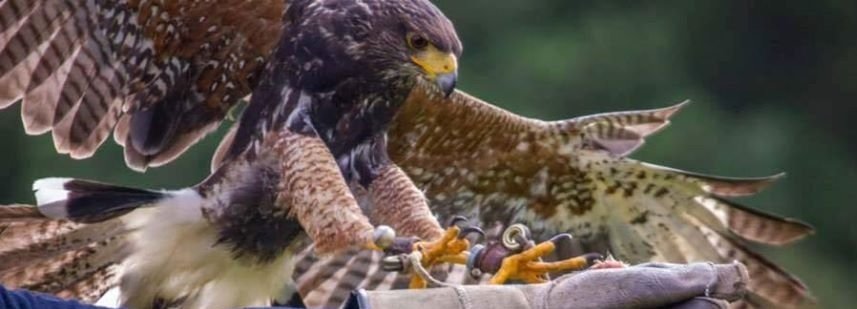
Across the species (eagles, buzzards, hawks, falcons and owls), birds of prey will have distinct and particular features that give them their apex hunter’s advantage. These features include wing shape, flying style and speed, feather colour and type, manoeuverability, leg length and more, but - because of how they hunt and kill - all birds of prey have powerful feet and a strong, hooked beak.
In eagles, the feet are very large and can exert very high pressure. A bald eagle, for example, has the strength to apply 400 pounds per square inch (psi) of pressure in its enormous feet, which is ten times the grip of an average adult human. The golden eagle’s prey can include mammals the size of a roe deer or fox, so their feet and talons need to be capable of a strong grip for lifting and carrying away that kind of weight, as well as the killer pressure needed to crush mammal bones.
In the images above, you can see the impressive feet on Altai, our golden eagle. Steve’s falconry glove is triple thickness to protect his arm but, even so, if Altai decides to apply pressure, Steve knows about it! To give you an idea of his size, Altai’s talons alone are each around 5-7cm long…
Falcons catch their prey on the wing, or in mid-flight, so they need to have feet that can bind to their quarry and hold on to it but they also need a quick method of killing their prey before it wrestles free in the air or damages them in the process of struggling to escape. The hooded beak of a falcon includes an extra serrated bit on the upper part of the beak. It looks like a notch - a rough edge - and its known as, a ‘tooth’, specifically a tomial tooth, which is used a little like a can opener. Falcons and (kites) use this tomial tooth to quickly kill their prey by snapping the vertebrae. You can see it in the image below, on Logan’s upper beak.
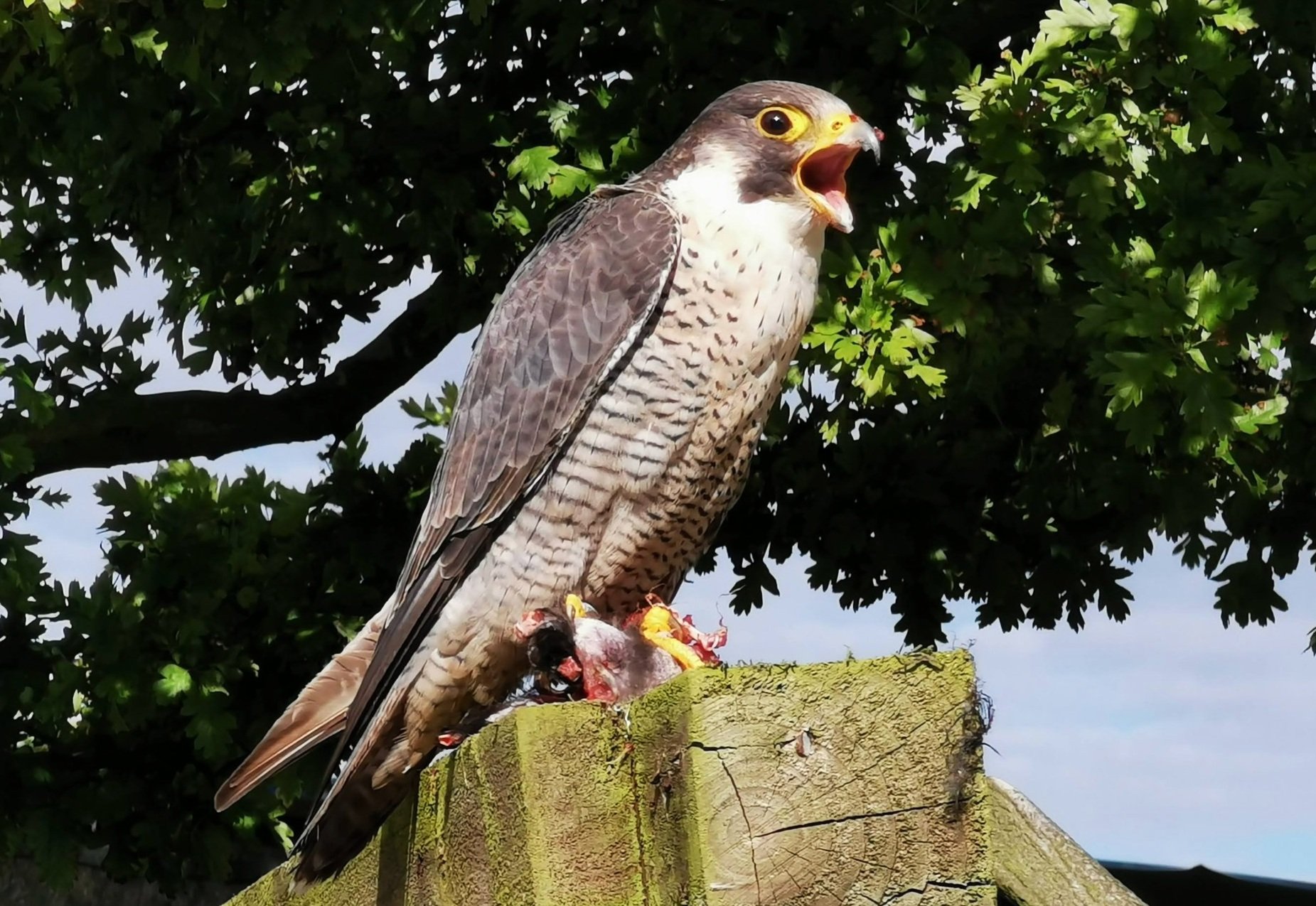
LOGAN our peregrine falcon showing his tomial tooth.
The two photos below show off the falcon’s tools of the trade: hooded beaks, powerful feet and strong, sharply pointed wing tips, giving them the aerodynamic profile they need to cut through the air at high speed.
Another feature of birds of prey that makes them different from other birds and most other animals is that the males are smaller than the females, which is known as reversed sexual dimorphism.
In most vertebrates, and in non-predatory birds, the male is typically larger than the female. However, in birds of prey, the female is larger. The most noticeable size difference is in falcons and hawks - in some cases (the kestrel, for example) the female is larger than her male counterpart by as much as 50%.
Ailsa, our female eagle owl (right) weighs approximately 6.5lbs (2.9kg), while Fergus, our male eagle owl, is just 4lbs (1.8kg) - almost 50% lighter!
The size difference between sexes is much less obvious in birds of prey that predate on slower species. Vultures, for example, which rely on team work or others’ left-overs (and carrion) to be able to eat, have little size difference between the sexes.

Ailsa, our female eagle owl
There are several theories as to why birds of prey have reverse sexual dimorphism. These include the suggestion that males and females can more easily share territory if they are different sizes: birds of the same species will not be in competition for the same prey if one is significantly smaller / larger than the other. And perhaps a female’s need to produce and spend time incubating eggs accounts for her larger size - she needs larger reserves of energy.
No, raptors and birds of prey are the same thing. The Victorians called birds of prey raptors, from a Latin world meaning to plunder or take by force. This perfectly describes a bird of prey’s hunting style, which is to ambush its prey and then carry it off to a safe place to eat. (The term ‘raptor’ is also used for the group of dinosaurs known as Dromaeosauridae, the feathered lizards that include the Velociraptor made famous by the film ‘Jurassic Park’. Scientists are yet to confirm a direct evolutionary link between these bird-like dinosaurs and the birds of today, but they certainly share the same design of powerful feet and fierce talons as our birds of prey. )
There are 14 species of diurnal (daytime-hunting) raptors (falcons, hawks, eagles) and 4 nocturnal raptors (owls) in Scotland.
The diurnal Scottish birds of prey are: red kite, honey buzzard, common buzzard, goshawk, sparrowhawk, merlin, kestrel, golden eagle, white-tailed (sea) eagle, osprey, hobby falcon, peregrine falcon, hen harrier and marsh harrier. Below is a photo of Lewis, Steve’s goshawk on a pheasant kill. In it you can see his hooked beak and sturdy, powerful legs but his feet are covered in the pheasant’s feathers.

A goshawk on a kill
The nocturnal birds of prey found in Scotland are: barn owl, tawny owl, short-eared owl and long-eared owl.
The barn owl’s feet, used with such precision to capture thousands of voles and mice in a year, are covered with tiny feathers to minimise the sound of the air passing over them, allowing the owl to fly almost silently, in order to surprise its unsuspecting prey.
Eagle owls are now also to be found living wild in Scotland (having escaped from captivity) and Snowy owls are sometimes seen on the islands of the Outer Hebrides, but neither species is considered native.
I’ve included some reference below but I’m confident you’ll learn the most and get the most out of booking an experience with Steve!
In The Scottish Countryman’s team, we have a barn owl and two eagle owls, a golden eagle, falcons and hawks. You can get up close to and learn more about each of these birds in our bird of prey experience or owl experience. Steve explains each of the birds’ ‘super powers’ and demonstrates their hunting/flying styles for you so that you can really appreciate the specific distinguishing features that make them all such superb birds of prey.
https://web.stanford.edu/group/stanfordbirds/text/essays/Size_and_Sex.html
“Raptor. A Journey through Birds” (2016) James Macdonald Lockhart Fourth Estate
The Harris hawk is not native to the UK, so why is it such a popular bird in UK falconry?
Read MoreCelebrating the anniversary of Rhu’s arrival at Hammer Inn
Read MoreFeather maintenance is a high risk business!
Read MoreHappy Easter from Hammer Inn. Here’s how we celebrate it and why eggs are big news right now.
Read MoreEggs are one of our most popular foods and they’re familiar to everybody - especially at Easter - but how much do you really know about eggs?
Read MoreSpring in Scotland - the wildflowers of Hammer Inn.
Read MoreHawking with a Gos and a Vizsla
Read MoreWe bought Argyll, our baby Snowy Owl, from the Scottish Owl Centre in July 2018 when he was not quite 2 weeks old. He proved to be our most popular bird in his first summer with us and we really enjoyed watching him develop. It happens fast!
The rate of change of a fluffy owlet to a fully grown owl is astonishing and we think you'll enjoy the process, so we have been keeping a diary of Argyll's progress. Some of it has been shared on our Facebook group, The Scottish Countryman's Owls, but in this post we'll share more of the rapid growth and dramatic change in a snowy owl chick over just a 4-week period.
First, here's how Argyll looked when we first collected him:

Argyll’s first day with us
As you can see, Argyll was mostly covered in grey fluff, which is actually feather but doesn't yet look like feather! This covering serves two purposes: it keeps the young owls warm and it protects their incoming feathers. It’s a bit like padding!
Argyll’s beak was very prominent in his face, dark coloured and surrounded by most black feathering. His eyes were a pale yellow and very round in their outline. He sat on his hunkers, feet protruding and white feathers over this huge black talons. His feet are definitely worth a closer look! These are his future weapons, and already - even at 10 days/2 weeks old - they look pretty fierce, don’t they?!
Argyll settled in quickly, taking over the dogs’ bed for himself and making himself at home in a section of the sitting room where we put down a waxed table-cloth for him to potter about on.

Argyll decides to take over the dogs’ bed
Like all babies, he’d be full of beans one minute - exploring and busy and inquisitive - and then sleeping the next. Argyll just ‘crashed’ whenever and wherever his batteries ran out: face down, legs out behind him, feet turned upward, and looking a bit like a deflated balloon.
He was only about 10 inches tall - about 25cm - at this point, and not very elegant on the move. It’s tough to get about on your heels, though, and HOT in all that fluff…
The downy grey covering of fluff that Argyll started with changed to more recognisable feathers at the tail and outer edges of his wings first
The new feathers are a fabulous whiter-than-white, with black splodges that are characteristic of young and female snowy owls, but will mostly disappear when Argyll reaches full maturity in a couple of years time. Snowy Owl males are all white, as you’ll see from this image, below, comparing baby Argyll with his very handsome dad!
Day by day, Argyll’s feathers grow in, extending up his wings and filling out his tail. The photo at the end of this group of 3 was taken only 3 days apart!
And then the dark colouring on Argyll’s head starts to lighten and change, as white feathers grow to replace the dark ones around his eyes and beak.
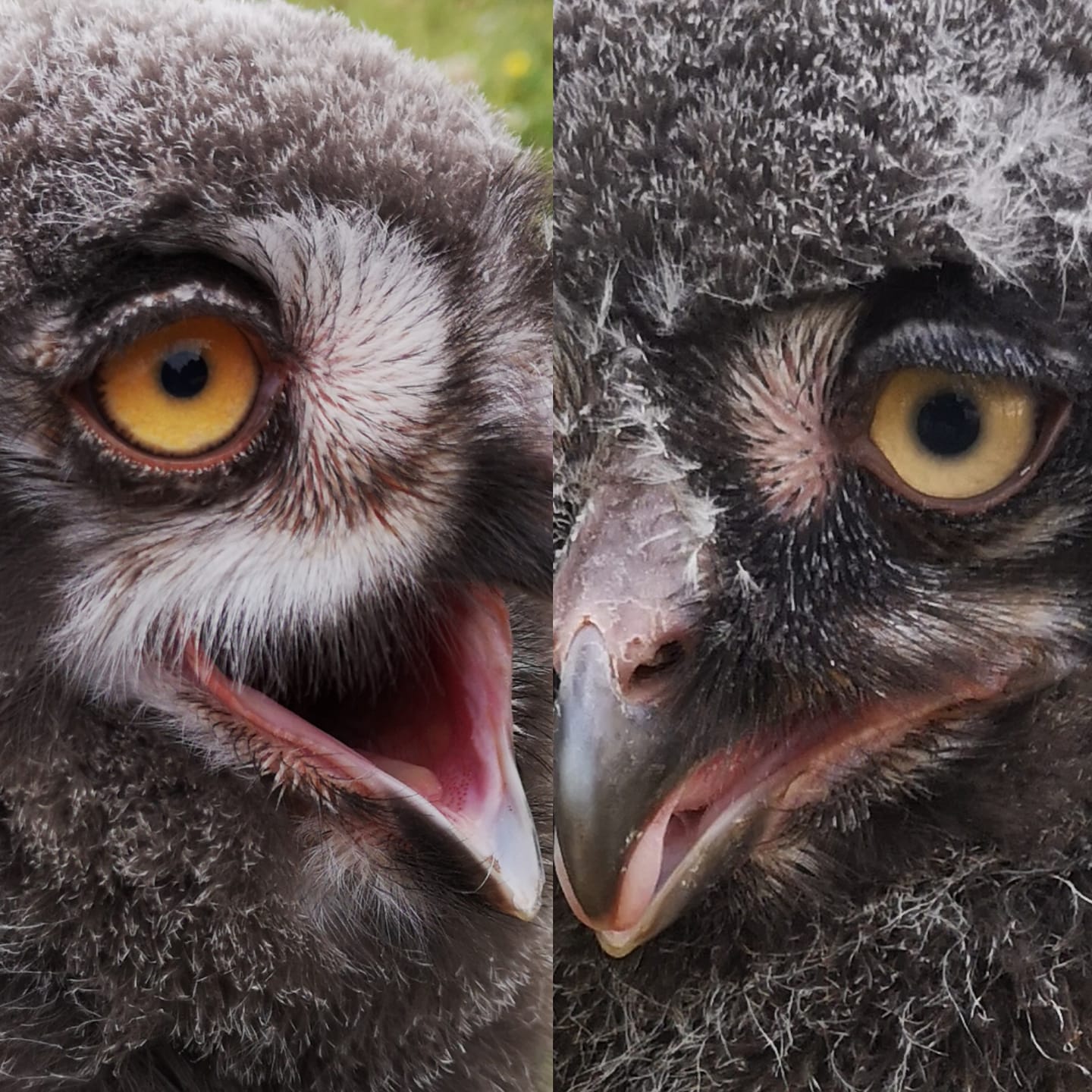
New versus old: feather growth changes Argyll’s face

Exploring outside
Argyll spent a lot of time roaming around outside each day, getting more active as his confidence grew and his mobility improved. His growing feathers are quite heavy, though, so he struggled a bit to manoeuvre them, seeming to surprise himself when he first started to flap his wings!
One week after he first arrived, Argyll is exploring his new flying field
As well as getting used to his new home, Argyll had to get used to the other animals here, including the other birds of prey (at a distance) and the dogs, Peter and Shinty. The dogs are used to birds, of course, but there’s always some interest in a new member of the team, so we are careful to introduce them gradually and to watch closely. Here’s Argyll just hanging out with Pete on a perfect summer’s day!

Peter the Patterdale terrier with Argyll
And exploring the mews area - where Fergus the Eagle Owl lives - on another sunny day…
As Argyll’s feathers came in, his size increased, doubling in the first two weeks and then growing rapidly for the next 2. I made the photos the same size to show his change in appearance in the before-and-after shot, below, but he was twice the height in the right hand photo!
When we weighed Argyll, 4 weeks after we first got him, he was 1.3kg - or 2.5lbs. He still has a lot of feathers growing and more to come through, which increases his weight.
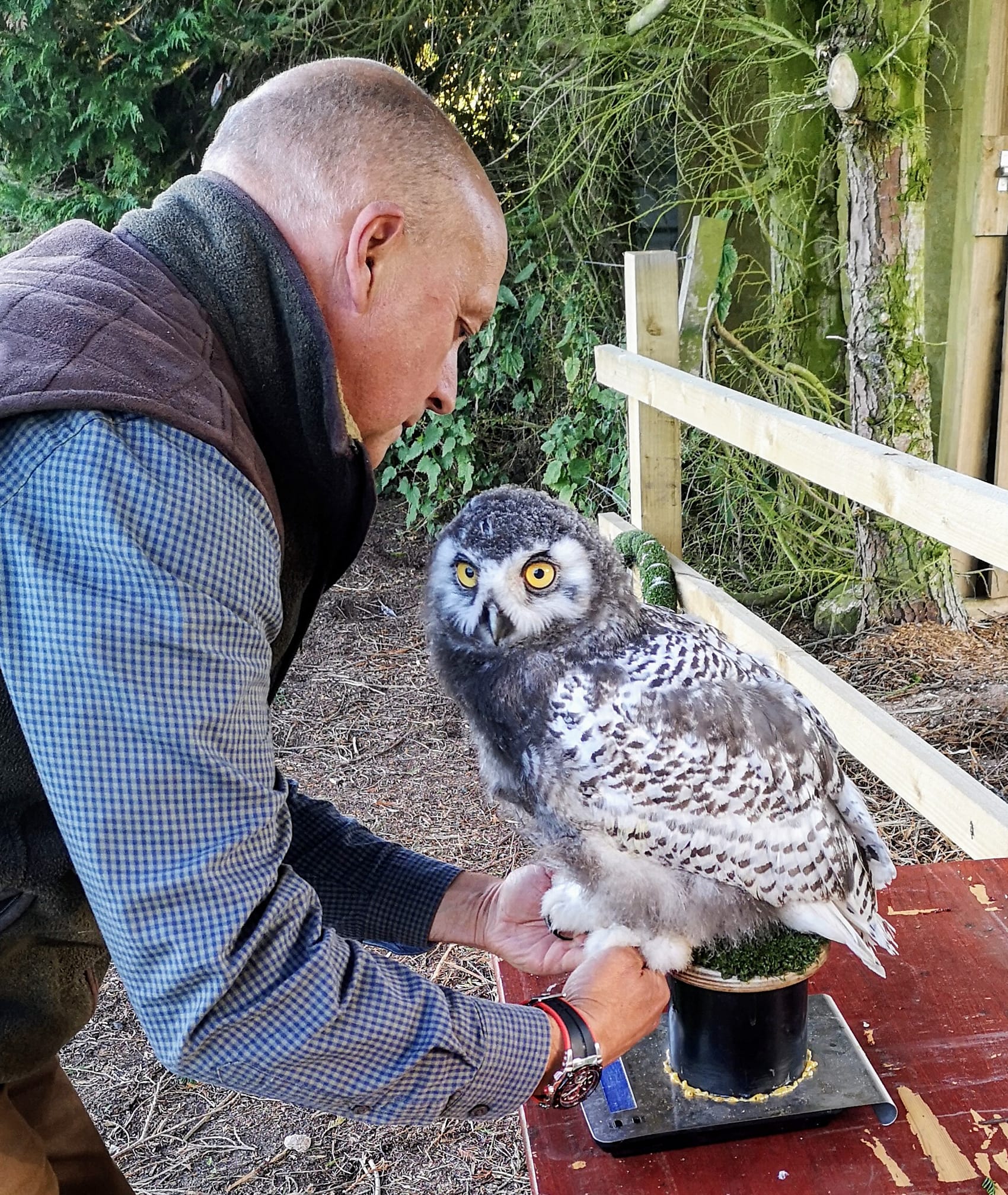
Steve weighs Argyll, August 2018
This is because feather quills that are growing are filled with blood, so are heavier than full-gown feathers. It’s a similar process to you growing finger nails. You have blood behind the new nail as it emerges from the nail bed, then no blood once it has grown out past the nail bed.
At 4 weeks after he arrived, approximately 6 weeks old, Argyll is almost fully grown. He only has another 2 weeks to go before he becomes fully-feathered and, at that point, his flying training will start in earnest.
Here’s what the early flying practice phases look like. You can see there’s a long way to go, but he’s got plenty of time and we’ll be covering Argyll’s progress in a subsequent blog post.
Anything you’d like to know about baby Snowy Owls? Post your questions or comments below. If you’d like to learn more about where we got Argyll, you might like to read my post all about The Scottish Owl Centre.
A key member of our team, Fletcher the male peregrine…
Read MorePeter Patterdale, Merlin Jim and Falconer Steve
Our little merlin, Jim, had a very lucky escape recently - he survived a buzzard attack! Here’s the story of our ‘Lucky Jim’. (Click on the images to enlarge them.)
Merlins are the smallest falcon native to the UK and, as you may already know, in birds of prey, the males are always smaller than the females. Our male merlin Jim is a tiny bird. He stands about 6 inches tall (15cm) and weighs in at only 5oz or 155g, approximately.
We got Jim in August from a top quality breeder of merlins based in N/E England. Steve has always loved merlins; he used to breed merlins about 25 years ago so he was delighted to have a wee falcon again and keen to get going with it.
“Getting going” with a new falcon means spending a great deal of time with it, in the first instance. The bird has to get used to you and its new surroundings, used to being handled and to its new ‘equipment’ - the jesses, leash and swivel.
As with all birds used in falconry in the UK, Jim was bred in captivity, so he’s not ‘wild’, as such, but he was certainly untrained. It’s Steve’s role as a falconer to train Jim, to prepare him to stand on the gloved fist, to be able to hunt, or to fly to the lure. He does this by taking him out every day, sometimes just to walk with him on the glove, other times to fly with him out in the fields surrounding our base at Hammer Inn or on site, using the lure to keep Jim’s attention here.
Jim settled in fast and was doing really well. People are often surprised that birds of prey have characters but they most certainly do and you can tell quite quickly what sort of character they have. Jim’s is easy-going; he’s very smart, gentle and keen. He and Steve clicked almost straight away and Steve was thoroughly enjoying training Jim. He even had Jim out hunting a couple of times (photos and video below), with Pete the Patterdale. (You can read more about merlin falcons and how they hunt in my blog post on Merlins.)
By early September, Jim was very much part of the team. Here he is (below) in the line-up of a static display at Wormistoune, where Steve did a falconry show to help with fundraising for Maggie’s Cancer charity. Jim was very steady on the block and his small size attracted a lot of attention, especially from children who thought his size made him a baby falcon. He is, in a way, having only been bred in May, but he is fully-grown, as all birds of prey are by the time they are 6-8 weeks old.
When not with Steve, Jim spends a lot of time on his block. He’s tethered, of course, to stop him flying away - just as you would put a lead on a dog to stop it running off - but sitting still for hours on end and just watching is what falcons do.
Birds of prey use flight as a means to escape or to hunt so one that’s fed is quite happy to sit for hours at a time, resting and not using energy unnecessarily. (It takes a lot of energy to fly!) It’s where the term ‘fed-up’ comes from: a bird that’s full (i.e. ‘fed-up’) won’t fly; it does nothing. So we say, when we’re bored and doing nothing, that we’re ‘fed up’. It’s an expression taken straight from falconry, like ‘under the thumb’!
Anyhow, one afternoon Jim was out on his block with the rest of the team and Steve had a falconry booking that he was preparing for. He had boxed the harris hawks and hooded the falcons and walked away from the weathering area to put some rubbish in the bin. Only a minute or two later he heard Jim’s kek-kek-kek cry, and knew Jim was in distress because he was shouting very loudly - an alarm call.
Steve ran back to the weathering as fast as he could.
When he came round the corner of the workshop, to his horror Steve saw a large female buzzard just taking off from beside Jim’s block, leaving Jim lifeless on the ground.
Footage from our CCTV camera
Steve went over to Jim and untied his leash and picked him up. Jim was completely still, and stayed limp in Steve’s hand. Distraught, Steve brought him into the house, convinced he was dead. However, once inside, Jim opened his eyes. He was breathing very heavily and clearly in distress so we thought he was dying and just held him in a blanket to keep him warm.
When a bird is attacked by another bird of prey, they are usually badly injured with puncture wounds from talons, or have feather and flesh torn off by the attacker’s beak. Because Jim was lying on his front, it was difficult to see any marks on him so we couldn’t tell what damage the buzzard had done.
Remarkably, within about twenty minutes, Jim started to move. We placed him inside a travel box - amazed that he could even stand - to give him a calm, quiet space to rest. But there still seemed little hope that he would recover.
A female buzzard weighs about 3lbs or 1.3 kgs and is around 21 inches (55cm) tall, so that’s quite a size advantage over little Jim!
Steve reckoned she’d only had half a minute or so on Jim before Steve had run back to the weathering but that’s more than enough time to have inflicted fatal damage. And if he was somehow, incredibly, not badly wounded, would Jim survive the shock?
Later that evening, to our surprise and relief, Jim was still alive and Steve managed to get him to eat a little. Jim had blood on his cere (the blue bit above his beak where his nostrils (known as nares) are and he was breathing heavily so still plenty to be concerned about. However, Jim spent the night in his travel box and was still going strong in the morning.
We are hugely fortunate to live near an experienced and expert falconer-vet, Keith, who practises out of the Eden Veterinary Practice at Cupar. Keith agreed to fit Jim in that morning so that he could be checked over and given antibiotics. When Steve came back with Jim later that day, we were both astounded: Keith could find no obvious signs of injury (other than the bit of blood on his cere); Jim had the laboured breathing but, otherwise, seemed fine!
You can see from the video (above) how hard the buzzard whacked Jim and you can see that she pinned him down and that Jim stops moving. It looks like she held Jim by his head with one of her talons (explaining the blood on his cere) and, perhaps, that blocked his airway so that he lost consciousness. In fact, that may well be what saved Jim’s life: it may have stopped the buzzard going in for the kill because she may have thought he was already dead.
Keith had said Jim was to be on antibiotics for 5 days and - if he made it to then - should be fine. He did and he is! He gained a little weight - up an ounce to 180 grams - which really made his feistiness come through, but that was the only change in him. Lucky Jim!
Steve’s next job was a net job. He wanted to protect the birds when they are sitting out on the weathering lawn so he ordered some 4” predator netting (used to protect ponds from herons, and the like) and installed it across the entire weathering. It’s perfect - reassuring but not too distracting.
The buzzard watched from a distant fence post while Steve put the netting up but we haven’t see her since, so hopefully she’s got the message and moved on.
Jim has now fully recovered. The hunting season has passed so it’ll be next year before Jim gets to go out hunting again with Steve and Pete. He’s back in his mews at night and frequently out on his block by day, but now safe(r) under the predator netting.
Jim’s definitely proved he’s a tough little bird and his resilience has been remarkable. He’s still in his first year, of course, and could live until he’s 12 - 15 years old, so we hope he’ll have many more years with us.
If, in time to come, you visit us for a falconry experience, I hope Jim’s still here for you to see*. And when you do, you’ll know why we might sometimes refer to our merlin as Lucky Jim.
*Or not… as it turned out. I’m sorry to say that Jim died suddenly, only a couple of weeks later, and just when he seemed to be fully recovered. We reported the news on our Facebook page.
I hope you enjoyed Jim’s story. (And if you were one of the many people who sent messages of support and good wishes to Jim on Facebook and Twitter when all this happened - thank you very much!)
Anything else you’d like to know about Jim? Or about merlins? Please ask in the comments below.
Deborah Brazendale
The Scottish Countryman delivers engaging and entertaining experiences that hep you connect with the Scottish Countryside.
Falconry, Archery, Country Sports and Countryside Consultancy.
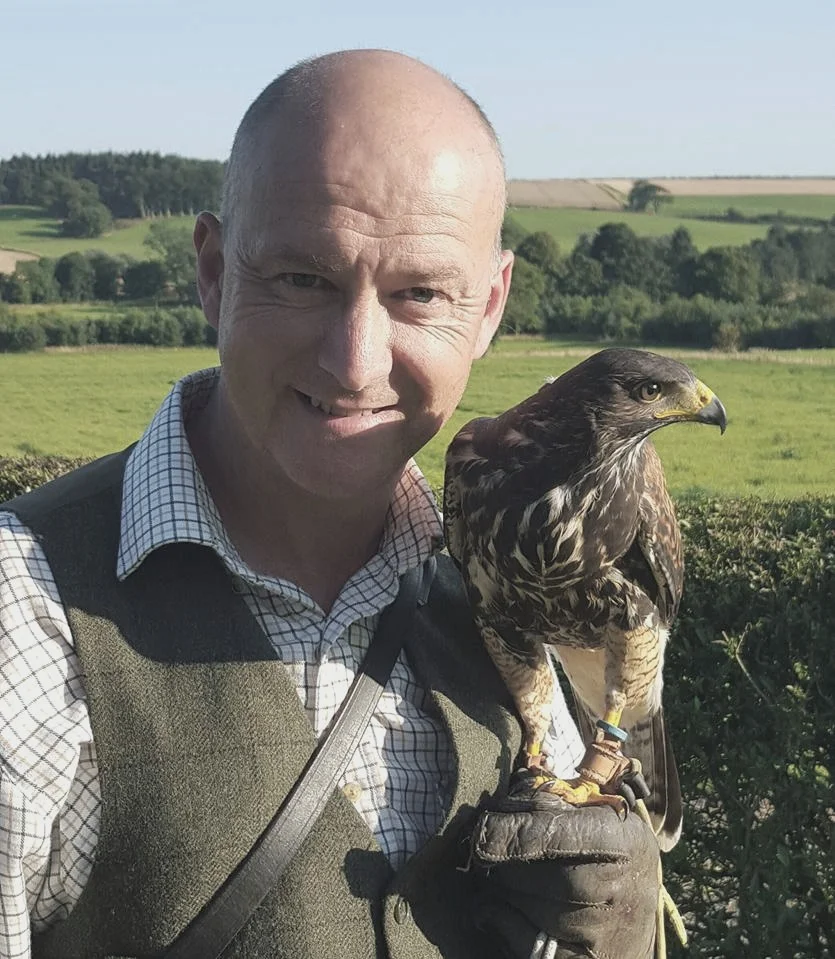
Steven brazendale
Steven Brazendale
0044 (0)7801 544 124 thescottishcountryman@gmail.com
Insider’s info delivered to your inbox. Spam free, guaranteed.
Our entrance on the A917, St Andrews to CRAIl road